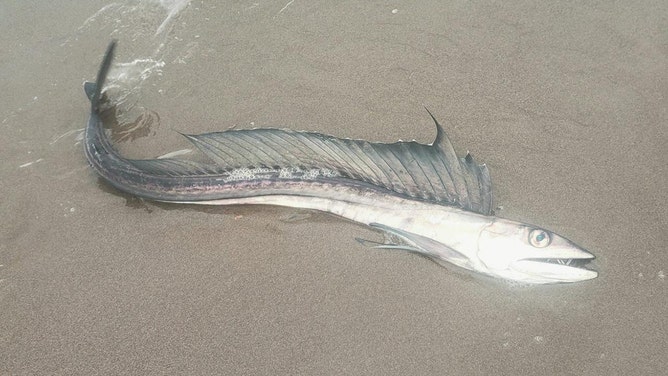Officials stumped after cannibalistic 'twilight-zone' fish wash ashore on Oregon beaches
From their fierce-looking teeth, bulging eyes and sail-like fin, these prehistoric-looking lancetfish look like they once swam with dinosaurs.
Australia scientists discover rare fish species on Indian Ocean floor
Senior Collections Manager for the Museums Victoria Research Institute Dianne Bray says never-before-seen marine life likely includes a blind eel, cucumber fish, and deep-sea batfish.
NEHALEM, Ore. – Notorious cannibals once lurking in the cold and dark mid-water ocean depths known as the "twilight zone" are washing ashore on Oregon’s beaches.
From their fierce-looking teeth, bulging eyes and sail-like fin, these prehistoric-looking lancetfish look like they once swam with dinosaurs.
Oregon State Parks said several of the scaleless fish had been spotted on the shore in the last few weeks from Nehalem south to Bandon.
According to NOAA Fisheries, they are one of the largest deep-sea fish. Their dinosaur-worthy scientific genus name, Alepisaurus, means "scaleless lizard." They can grow to more than 7 feet long and can swim to depths more than a mile below the sea surface.
SEE THE MASSIVE WORLD-RECORD FISH CAUGHT BY NORTH CAROLINA ANGLER

From their fierce-looking teeth, bulging eyes and sail-like fin, these prehistoric-looking lancetfish look like they once swam with dinosaurs.
(Oregon State Parks)
Wildlife officials said the deep-sea fish live in tropical and subtropical waters and can migrate as far north as the Bering Sea to feed.
Since 1982, NOAA groundfish surveys have found two lancetfish in the Gulf of Alaska, four near the Aleutian Islands and 10 in the Eastern Bering Sea, NOAA Fisheries reports.
"No one is sure why they are washing ashore," the parks department said in a Facebook post with a photo of a recent lancetfish that was found alive and helped back to the ocean.
The agency said if you see one of these fish on the beach, take a photo and notify officials.
